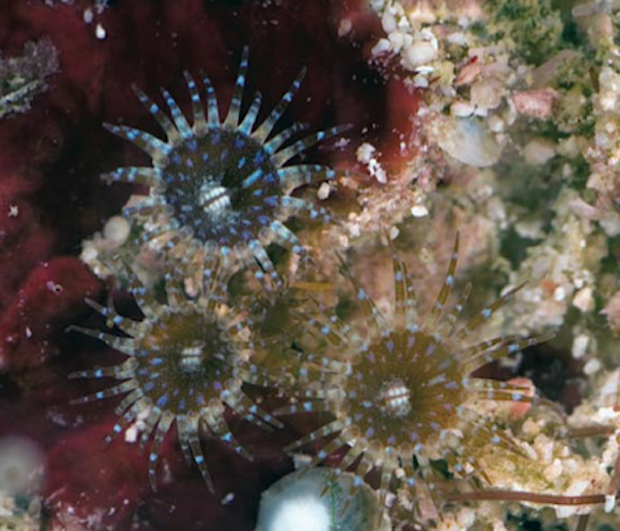Neozoanthus is a very little known group of zoanthids in the aquarium hobby but today we learned a little more about two new species: Neozoanthus uchina and N. caleyi. This funky genus of zoanthids was thought to be rare, it’s even been assigned to its own family Neozoanthidae, and up until recently Neozoanthus was known only from a single species discovered in Madagascar called N. tulearensis.

In a way Neozoanthus polyps look a lot like mini anemones with flat smooth oral discs and long pointy tentacles, more similar in appearance to a small flower anemone than your everyday zoas and palys. We’ve seen these types of polyps coming in on a semi regular basis to aquarium outlets as zoanthid rocks or along with other zoanthids, green star polyps and mushroom anemones. The two new Neozoanthus species N. caleyi and N. uchina come from Japan and Australia respectively, so there’s some chance that one or both of these could be the species we’re encountered in aquaria.
Neozoanthus uchina is so far only known from certain location in Southern Japan such as the islands of Okinawa where it has been documented to be locally abundant. The Japanese N. uchina is characterized by “tentacles [. . .] usually shorter than the expanded oral disk diameter (e.g. 50-80% of oral disk width)” and a coloration that ranges from grayish-blue, rust red, or transparent, often with black, white, or fluorescent blue bands or patterning”.
Neozoanthus caleyi was first collected on the great barrier reef during the Census of Marine Lifewhich yielded so many great marine biological discoveries. In the provided images N. caleyi has potential to be very pretty with the official description mentioning that the “oral discs may be light gray-blue, white, or deep wine red. Occasion- ally, white, yellow, or light blue dots may be seen on the oral disk in regular circular patterns, and the oral opening (mouth) is often white in color. A “skirt” of different coloration (usually white or lighter coloration than remainder of oral disk) covering up to approximately 90 degrees of the oral disk”. Did you catch that? Even the scientists refer to certain features of zoanthids as “skirts” – who knew?
Now that we know what Neozoanthus look like we’re certain that the zoa collectors will start finding, growing and naming them – not necessarily in that order – and we’ll start seeing them in reef aquariums in no time. If you ask us it even looks like one of the four new species of Florida zoanthids, the one called the “butterfly paly” may actually be a species of Neozoanthus – but that is far from confirmed. [sci-news]






